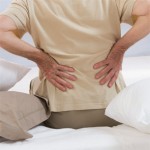Each of these risk factors can be easily and quickly assessed during an office visit. During assessment, someone should be nearby as a safety precaution, and any of the usual aids (e.g., cane or walker) should be used. If this risk assessment suggests the person is “at risk” for falling, further assessment and interventions can be recommended. Just a few simple screening tests are described; more extensive tests should be done when that seems indicated.
Physical function, especially of the lower extremities, can be evaluated through observation of the patient’s mobility and gait, as well as by self-report. Individuals can be asked to perform simple movements such as walking across the room and rising from a chair. Notations to make on the patient’s record might include any observation of unsteadiness, noticeable muscle weakness, and limited range of motion (e.g., in the ankles, knees, or hips). Walking can also give some indication of one’s ability to balance. Are persons steady as they rise from a sitting position and begin walking? Balance can be checked by noting if the patient can stand with eyes closed in a “near-tandem” position (i.e., with the feet 1 inch apart and the heel of the front foot 1 inch in front of the toe of the back foot) for 30 seconds. Inability to do this indicates poor balance.6 If more extensive assessment seems warranted, specific tests such as the HAQ-DI16,17 and the Timed Up and Go Test18 are available. Administering these tests takes more time, but they probably can be accomplished in approximately 20 minutes with most patients.
Vision screening is important. Because of the number of problems (e.g., visual acuity, cataracts, macular degeneration) that can affect how one sees, one of the most basic questions to ask is, “Have you had your vision tested by an eye doctor during the past year?” Self-report of vision problems may also indicate risk of falling. A simple screening test that can be done is a low-contrast visual acuity test, using a chart similar to the Snellen chart and testing the individual’s ability to read at a distance of 10 feet or three meters. This alternate test is recommended because those with low-contrast visual problems may have more problem seeing those things within their environment that could be hazardous.6 These charts are available for purchase.
Assessing the fear of falling is also important to know whether measures should be taken to increase the person’s confidence in performing independent activities. Again, one question may be asked: “Do you limit any of your activities because you are afraid of falling?” If the answer is “yes,” then further questions may be asked to determine 1) if there are specific factors (e.g., impaired physical function or vision) contributing to this fear, and 2) how this fear is affecting one’s function. Most intervention studies for fear of falling have used a version of the Falls Efficacy Scale19 to assess the confidence one has in performing common activities (e.g., getting in and out of a chair, walking around the house) without falling. It provides a practical approach to assessment, as it should take approximately 5 minutes or less in most cases.

